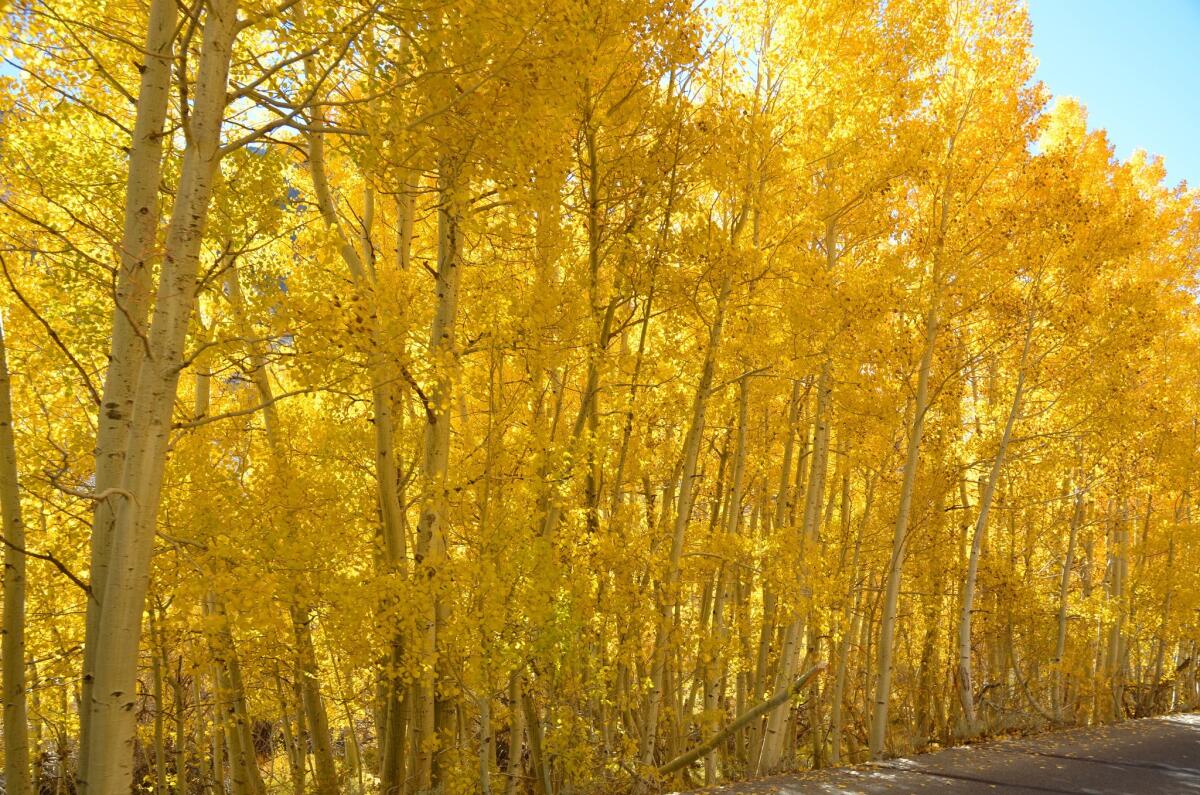It’s autumn! California’s fall color spots are starting to pop
- Share via
For those who miss the shimmering red, orange and yellow marvel of fall in the East, listen up: The Golden State — famous for its tropical palms, gracious live oaks and towering redwoods — also is home to trees that lose their leaves after a short but spectacular display of autumnal color.
Right now, the California Fall Color blog shows some golden aspen leaves at the 9,000-foot level at Virginia Lakes north of Mono Lake in the Eastern Sierra. Even an early dusting of snow last week didn’t hurt the trees. The season unfolds between mid-September and mid-November, with timing dependent on the trees’ elevation, wind and weather.
The pleasure and pain points converge in the annual evaluation of your summer moments.
Check the frequently updated blog for show times. Here are seven sites on the blog’s color-guide map where you can discover your inner leaf peeper.
Eastern Sierra
Thanks to the past year’s record moisture and lingering snowpack, the colors of the aspen, cottonwood and willow trees on the eastern slopes of the Sierra are expected to be more dazzling than ever. Leaves are already turning at higher elevations and will peak in mid-to-late October at lower elevations. Avoid the five-plus-hour drive from Los Angeles to the Eastern Sierra by taking a short flight from LAX to Mammoth Yosemite Airport.
Info: California’s Eastern Sierra
June Lake Loop
The 15-mile June Lake Loop drive passes along the shores of four mountain lakes that mirror the magic of quaking aspen: Because aspens spread their roots and sprout hundreds of cloned trees, when their leaves quiver in the wind it looks as if yellow butterflies are swarming the hillsides. June Lake will celebrate fall foliage with the first “Leaves in the Loop” Festival Oct. 18-20. From U.S. Highway 395, turn left onto California 158.
Info: Fall Foliage in Mammoth Lakes and June Lake
Mammoth Lakes Basin
In this popular Sierra ski resort they call the time between summer and the first snow “outside on the Eastside.” Days are chilly but clear, lodging is a bargain, and visitors can enjoy hiking, biking — and new this year e-biking — surrounded by stunning fall colors. Roads and trails thread among Mammoth’s six tree-lined mountain lakes and climb to elevations of 10,000 feet. At Lake George, the highest car-accessible lake, photographers will find magic hour just after sunrise. From U.S. Highway 395, take California 203 west in Mono Country. Take exit 263 toward Mammoth Lakes/Devils Postpile.
Info: Mammoth Lakes Basin
It takes patience and talent to capture these creatures’ best moments. Here are photo submissions from our Summer Vacation Photo issue.
Bishop Creek Canyon

Bishop, an Owens Valley town set against a backdrop of saw-toothed Sierra peaks, is the starting point for a 19-mile drive up into the mountains and 10,000 foot-high Bishop Creek Canyon. The quaking aspens compete with the cottonwoods for your attention along the shores of Lake Sabrina, South Lake and North Lake. The recreation area is known for rock climbing, fishing and hiking, which are all more fun framed by fall colors. Take U.S. Highway 395 to Bishop and then California 168 west to Bishop Creek Canyon.
Info: Parchers Resort Fall Color Report
Sonoma Valley
In fall, Sonoma vineyards turn yellow and crimson, and forested hillsides become speckled with gold. Look down on the valley’s patchwork of colors from the Sonoma Overlook Trail, which winds up a hill from the town. On a fog-free day, you can see all the way to San Francisco. The Sonoma County Vineyard Adventures’ program offers self-guided walks through the vineyards, best finished with a wine tasting. From Interstate 80 west, continue onto California 12 west (look for signs to Napa/Sonoma).
Info: Sonoma County Tourism
Big Bear Lake
At 6,752 feet, Big Bear Lake in autumn offers crisp clean air and the yellow, amber and crimson hues of black oaks, cottonwoods and maples among the evergreens. Trails for hiking and biking abound near the lake and in the surrounding San Bernardino National Forest. In Big Bear Village, family activities include pumpkin patches, haunted houses and flashlight safaris at the Big Bear Alpine Zoo, home to rescued bears, bobcats and other forest animals. The spirited Big Bear Lake Oktoberfest runs on weekends until Nov. 2. Take California 330 north to mountain resorts.
Info: Big Bear Discovery Center
Julian
In northern San Diego County, the old mining town of Julian exudes a nostalgic charm that harks back to its short-lived 19th century gold rush. Today the fall apple harvest attracts visitors. Take walks along country roads lined with color-popping poplar, willow and oak trees. Browse antique shops, enjoy a slice of fresh-baked apple pie and cozy up in one of the town’s quaint B&Bs. Take the 15 Freeway south to California 76 east.
Info: Visit Julian
Southern California
In L.A. you’ll discover the occasional street lined with maple and eastern oak trees whose leaves turn yellow, orange and crimson. For pure gold, seek out the fall foliage of the ginkgo tree. Considered a “living fossil,” the ginkgo has changed little in its 270 million years. It looks much the same as it did when dinosaurs munched on its fan-shaped leaves.
In Tokyo the Japanese cherish autumn’s golden ginkgoes as much as spring’s pink cherry blossoms. The best places to find ginkgo trees in Los Angeles are in the Japanese Garden at the Huntington Library, Art Museum and Botanical Gardens in San Marino; the Japanese Garden in the Sepulveda Basin Recreation Area in Encino; and the Los Angeles Zoo & Botanical Gardens in Griffith Park. Call ahead to check, but November is usually prime time to go for the gold.
More to Read
Sign up for The Wild
We’ll help you find the best places to hike, bike and run, as well as the perfect silent spots for meditation and yoga.
You may occasionally receive promotional content from the Los Angeles Times.






